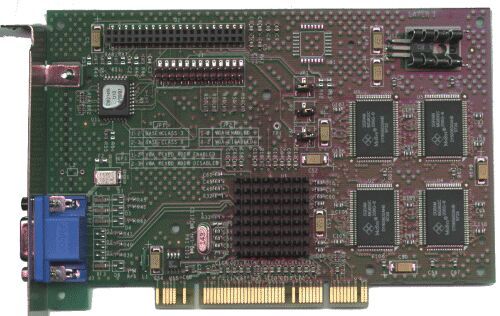Hercules Dynamite 3D/GL
The Hercules Dynamite 3D/GL was based on the 2D/3D graphics engine Permedia2 by 3DLabs. It launched in late 1997.
|
Released | December 1997 |
| Bus | PCI | |
| Chipset | 3DLabs Permedia 2 | |
| Standards | VGA | |
| Memory | 4 MB or 8 MB of SGRAM | |
| RAMDAC | - | |
| Ports | 15-pin DSUB (analogue RGB video out) | |
| Part # | D6218GL, D7218GLA | |
| FCC IDs | - | |
| Price | At launch: $284 March 1998: $229 |
|
| See Also | Dynamite 128, Stingray 128 |
Board Revisions
No information on board revisions for the Dynamite 3D/GL is known.
Competition
A poor-performing card when compared to the Diamond FireGL.
In the Media
"The new Dynamite 3D/GL is using 3DLabs :Permedia 2 chip, so that shows you where to put the Dynamite 3D/GL, it's pretty much Hercules' first professional card for a long while. 3DLabs' Permedia 2 is known for very good 2D performance, the best OpenGL performance in this price group and a pretty good Direct3D performance as well, although it's not offering the highest 3D image quality due to some missing features.
I am happy to see a Hercules product with this chip, which in my eyes is one of the best 3D chips currently available, unless you're a hardcore gamer who doesn't care for anything else.
Due to the fact that I've only received the card here in Fremont, CA, it will take until after Comdex to run tests and benchmarks, but we could expect higher results than with Diamond's Fire GL 1000 Pro, because the Permedia 2 chip is clocked with 90 MHz or even more against only 83 MHz in case of the Diamond card."
Toms Hardware, November 1997
"The Dynamite 3D/GL fared somewhat better across the board, thanks to its implementation of 3Dlabs' Permedia 2 accelerator. The Permedia 2 combines 2-D and 3-D operations on a single chip, and dynamically allocates all of its on-board memory to any task at hand; it even uses a few of its 3-D capabilities to accelerate some 2-D functions, such as pattern fills and video acceleration. The Permedia 2 also integrates 2-D, MPEG-2 video, and 3-D acceleration under both Direct 3D and OpenGL.
During testing, the Dynamite 3D/GL posted top-tier scores in our 2-D test suites, performing within fractions of a point of the leader in Winstone and among the leaders in WinMark. In 3-D testing, the card matched or bettered the Stingray 128/3D's quality and performance, and was again among the leaders.
The video quality of both boards was quite good; both are capable of displaying multiple simultaneous video streams with little apparent effort. Both boards also support a wide array of 3-D features and effects. During testing, the Stingray 128/3D correctly implemented perspective correction, specular highlights, alpha blending, fog, and several MIP-map modes (but not linear MIP-map combinations). The Dynamite 3D/GL matched its cousin feature by feature, though the driver we tested with had minor trouble with some fog modes.
In the rapidly changing world of PC graphics engines, the multichip Stingray 128/3D looks outmoded in comparison with new single-chip multifunction boards such as the Dynamite 3D/GL. The latter card offers greater flexibility and somewhat faster performance, with little noticeable trade-off in quality. While dedicated gamers may appreciate the Stingray 128/3D's high-quality 3-D output, general business users will be happier with the Dynamite 3D/GL."
PC Magazine, December 1997
Setting it Up
I have no information on setting up the Hercules Dynamite 3D/GL.
Downloads
Operation Manual Get in touch if you can provide this missing item! |
Original Utility Disk Get in touch if you can provide this missing item! |
|
